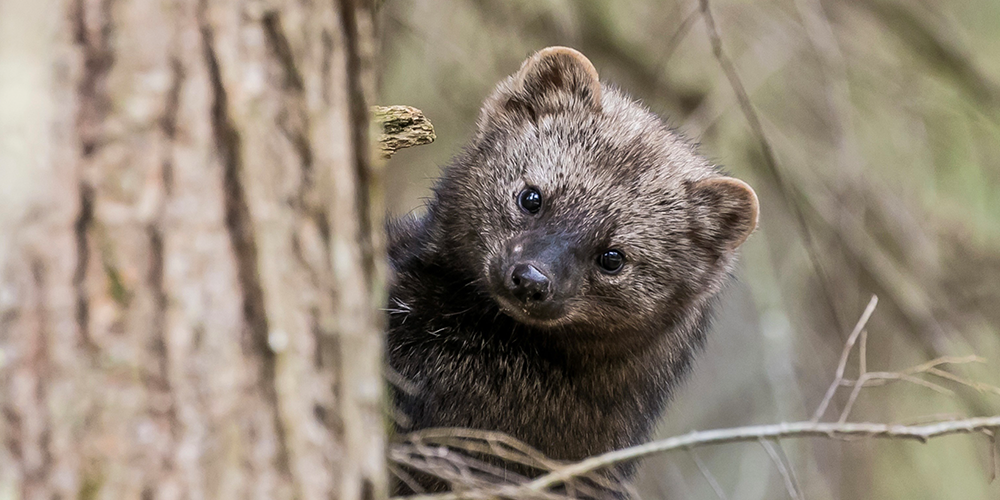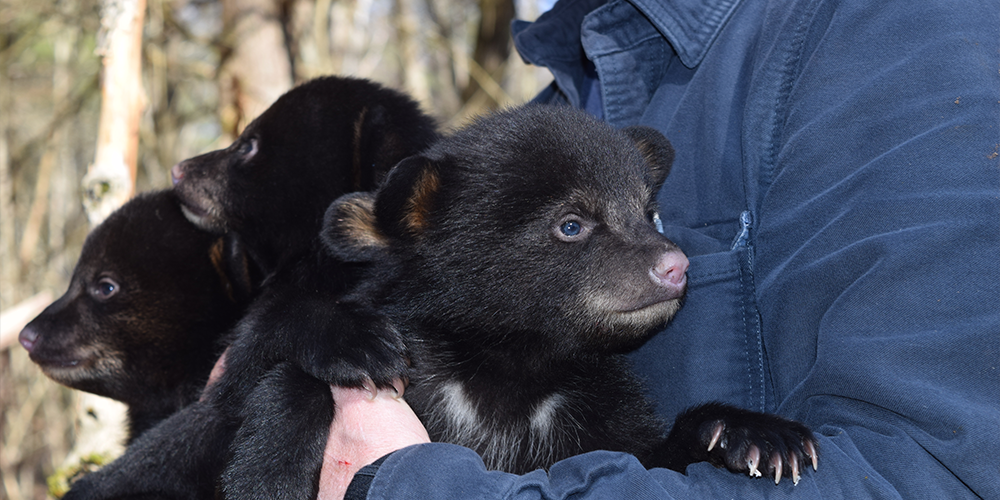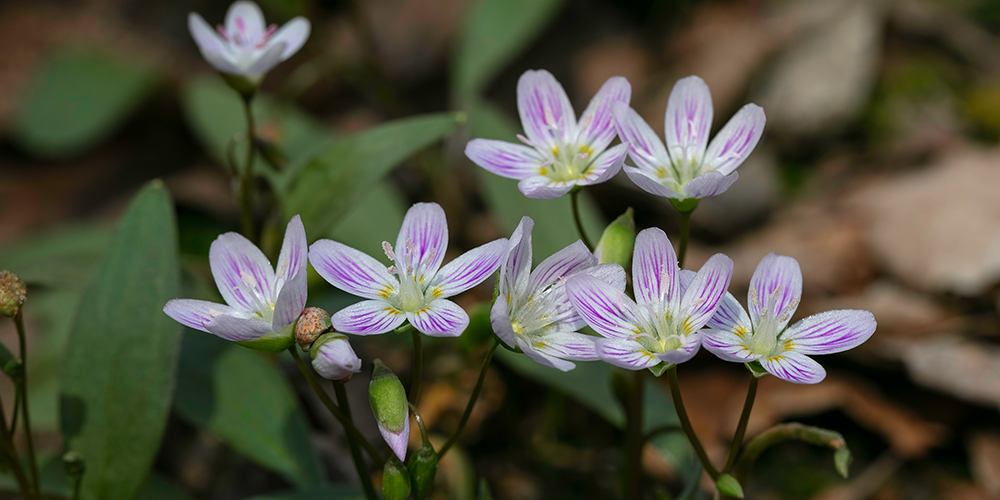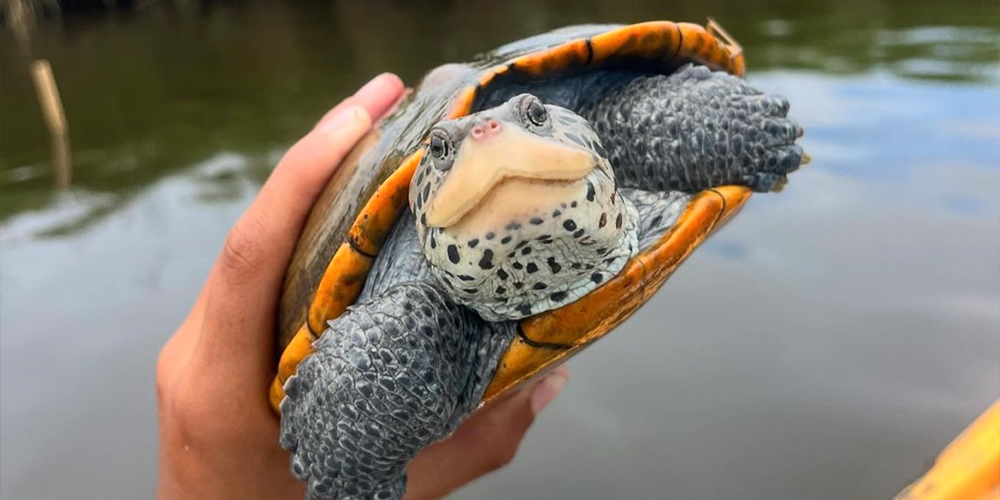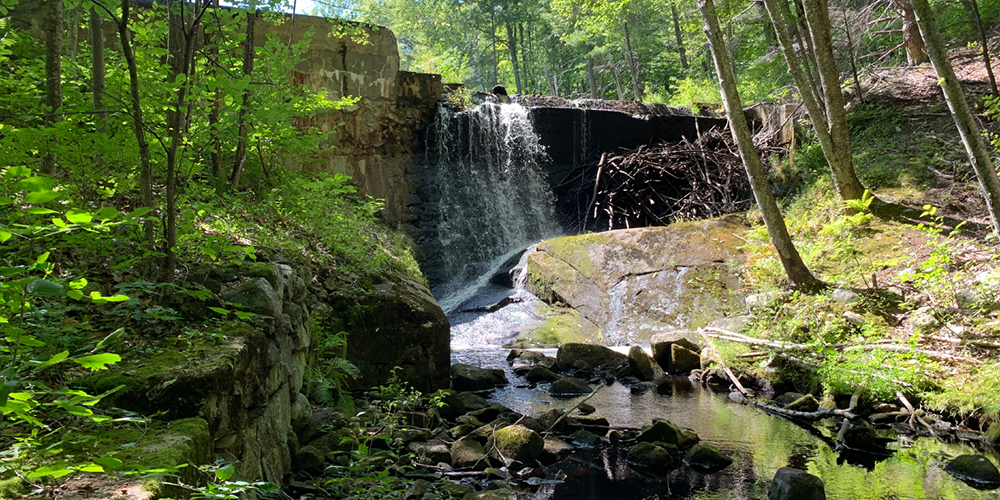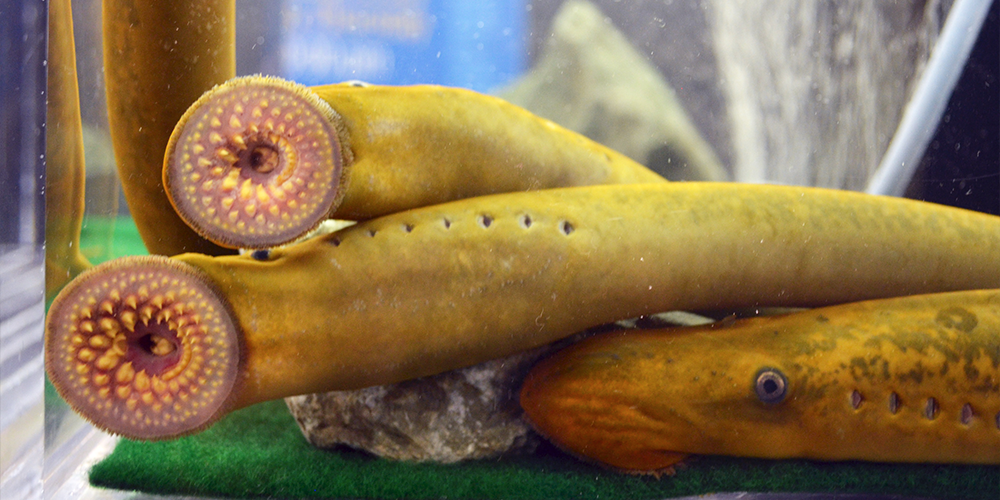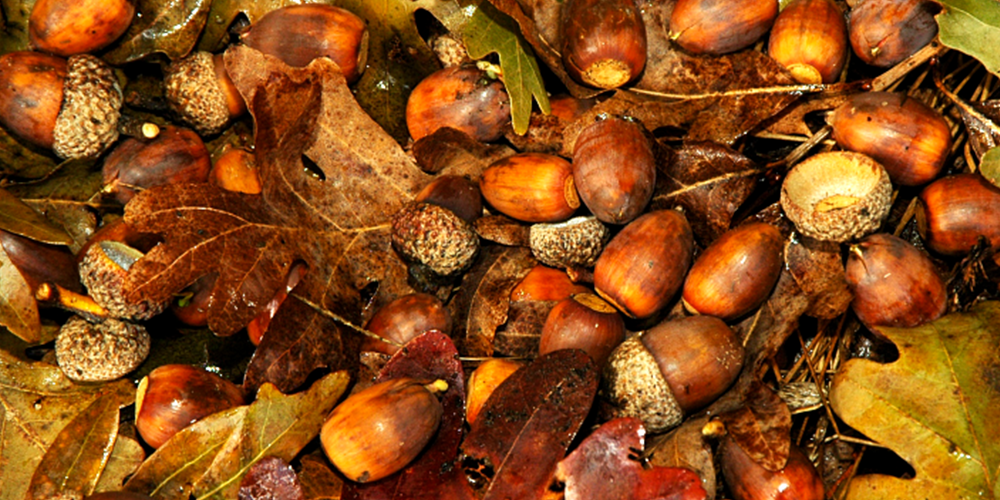Ten popular wildlife stories from 2024
1. Subterranean science: Tracking bats in MA
This winter, MassWildlife biologists and staff surveyed abandoned mines and natural caves in western Massachusetts looking for hibernating bats. To do this, biologists carefully entered the mines and caves in late winter to identify and count individual bats, check for signs of disease, and check the security of the mine or cave. This year, MassWildlife and the Department of Conservation and Recreation (DCR) explored a new property and found two previously unknown bat hibernation sites! Data collected from these surveys help our biologists determine how to best protect endangered bats in Massachusetts and help them recover. Dive deeper into MassWildlife’s bat surveys.
2. Fishers: fact vs. fiction
Fishers, sometimes called "fisher cats," are elusive and often misunderstood creatures. Though they’ve gained a reputation as vicious predators, fishers are shy and solitary, preferring to avoid humans whenever possible. Because they are rarely seen, many people don’t know much about them. Why are they called fishers? How big are they? Will fishers attack people or pets? Do they scream? Find these answers and more as you separate fact from fiction.
3. Frequently asked questions about rattlesnakes in MA
Many residents are surprised to learn that Massachusetts is home to timber rattlesnakes. We posted a video filmed by our State Herpetologist of a timber rattlesnake displaying its name-sake behavior of rattling the end of its tail and it prompted many questions from Massachusetts residents about these fascinating snakes. Why do rattlesnakes rattle their tails? What should you do if you see a rattlesnake? How big are they and what do they look like? Why are rattlesnakes endangered and how are they being conserved? Find the answers to these questions and more.
4. Researching black bears in a mild winter
For the last 40 years, MassWildlife biologists have visited bear dens in the winter to collect valuable data. The limited snowfall and warmer temperatures experienced this winter presented a new challenge for this decades-long research project. During den visits, biologists document the health and weight of the sows while weight, sex, and body condition data is recorded for cubs and yearlings. Read more about this long-running research project.
5. Spring ephemeral field guide
Early flowering plants that produce leaves, bloom, and set seed quickly after the snow melts in the spring are referred to as spring ephemerals. Many people look forward to the appearance of these appealing wildflowers with great excitement as they represent the change of season. Spring ephemeral flowers provide the much-needed first nectar and pollen of the season for over-wintering pollinators, including bumblebee queens, mining bees, halictid or sweat bees, early butterflies, beetles, flies, and gnats. Spring ephemerals are only out for a short time so bookmark this spring ephemeral field guide for warmer weather.
6. Tracking terrapins in the Buzzards Bay estuary
This summer, MassWildlife launched an exciting new project in partnership with Zoo New England to study diamond-backed terrapins in the unique ecosystem of Buzzards Bay. These medium-sized turtles are native to southeast Massachusetts and their numbers have been decreasing in recent years. To bolster conservation efforts, biologists first have to estimate the population and movement patterns of these turtles using a variety of techniques, including visual surveys, marking terrapins and recapturing, and acoustic monitoring. The first season of terrapin tracking was a success with the team documenting 915 diamond-backed terrapins. Take a closer look at this new turtle project.
7. Removing seven aging dams will benefit ecosystems and people
At the beginning of 2024, MassWildlife announced plans to remove dams that are in poor condition and have outlived their original purpose in Wildlife Management Areas in Athol, Sutton, Brookfield, Hardwick, Windsor, and New Braintree. Removing these dams will benefit wildlife by restoring stream function and allowing access to different areas of the watershed for different stages of their life cycles. Removing aging dams also benefits the people of Massachusetts by reducing safety risks, eliminating the costs associated with ongoing repairs and maintenance, and providing WMA visitors expanded access to natural landscapes. Read more about these dam removal projects.
8. Moving mussels to prepare for dam removal
Before the removal of the Quinapoxet Dam in West Boylston, MassWildlife and our partners moved freshwater mussels upstream. Freshwater mussels spend most of their lives filter feeding on stream and river bottoms and only travel a few feet throughout their entire adulthood. While dam removal projects are carefully planned to minimize and mitigate impacts to aquatic habitats, this project includes reconstruction of the stream bottom that mussels would not be able to survive because of their limited mobility. In total, 1,636 eastern pearlshell were moved to safety before construction began. Learn more about freshwater mussels near the Quinapoxet Dam.
9. Learning to love lampreys
With their suction-cup like mouth ringed with rows of sharp teeth, sea lampreys may not inspire affection at first glance. However, these native eel-like fish provide a variety of benefits to our aquatic ecosystems and do not pose a threat to people. Sea lampreys hatch in freshwater and spend their adult years in the ocean before returning to rivers to spawn. Once they spawn, adult lampreys die and nutrients from their bodies become available to other plants and animals in these rivers. Lampreys also restore and enhance the structure of streambeds when they build nests and lamprey eggs and larvae are food for a variety of other wildlife. Learn to love lampreys by reading more.
10. Acorns abound
Have you noticed a lot of acorns this year? The natural cycle of oak tree seed production can lead to an abundance of acorns and a welcome source of nutrition for local wildlife. Acorns are high in calories, fat, and essential nutrients like calcium, potassium, and phosphorus. Squirrels and white-tailed deer rely heavily on acorns in the fall and during the leaner winter months. Birds like blue jays, wood ducks, ruffed grouse, and wild turkeys also eat acorns. Acorns feed small rodents like mice and voles, as well as larger mammals like black bears. Read more about these nutrient-packed wildlife snacks.
What happens to wildlife during a fire
With well over 600 wildfires occurring throughout Massachusetts this past October and November, many people are wondering about the impacts to wildlife. The answer is more complex than you might imagine. The ability of animals to survive fire depends on their mobility and on the uniformity, severity, size, and duration of the fire. Most landscapes are quite variable, with hills, valleys, and wetlands, all of which burn at different rates and intensities, leaving patches where animals can take refuge. Occasionally, individual animals may be hurt or killed by fast moving flames and heat. Yet, fire is and has been a natural part of the Massachusetts landscape and can bring a variety of benefits to habitats that in turn, benefit wildlife.
What do animals do during a fire?
Most animals can readily smell smoke and move away from oncoming flames and heat. The impacts of a particular fire can vary greatly depending on windiness, the flammability of vegetation, the speed and intensity of a flaming front, or the severity of ground fire burning into organic soils. Our native wildlife have evolved strategies to escape and avoid the brunt of the flames and heat.
Birds fly up and away from the burning area or high up into the tree canopy. Larger mammals like deer, black bears, and bobcats readily move to areas of forest not impacted by fire. Smaller mammals like mice and voles retreat to underground burrows, while climbers like fishers and porcupines take refuge in treetops. Native rabbits may seek shelter in nearby wetlands. Amphibians and reptiles find safety by moving to wet areas or burrowing under the ground, logs, or rocks. Soil often provides insulation from the heat of fast-moving, lower-intensity fires. While some individual animals likely perished in the recent wildfires in Massachusetts, overall populations of wildlife are unlikely to be affected.
What do animals do after a fire?
The timeframe for animals returning to a burned area depends on the severity of the fire, the habitat, the season, and the type of animal. Certain beetles and other insects are the first to return as they are attracted to burn sites and use infrared sensors to quickly find burning stumps and other vegetation. Other animals return to a burned area within hours, days, or weeks after a fire. Owls, crows, turkeys, woodpeckers, whip-poor-wills, and other birds often return quickly to eat insects and acorns. Opportunists like foxes and hawks may return quickly to eat small animals that didn’t escape the flames.
Areas that have experienced fire will warm up quicker the following spring, and green up before the surrounding forests. White-tailed deer often come into recently burned areas for ash, minerals, fresh herbs, and tree sprouts. It takes longer for small mammals like New England cottontail to return. They often wait a few years for more cover to develop, but the shrubs and young saplings emerging after fire provide nutrient-packed food for these mammals.
Long-term benefits of fire
Periodic fires have been a part of the New England landscape for thousands of years. In fact, fires play an important role in rejuvenating vegetation and soils. In the months and years following a fire, many forest, woodland, shrubland, and grassland habitats undergo changes to the structure and composition of vegetation growing there. The result is a more diverse collection of native plants and improved habitat for wildlife. For example, fires can encourage vigorous growth of diverse native wildflowers, which in turn benefit a variety of native bees and butterflies.
Prescribed fire is a tool used by many agencies and organizations across the country to unlock the natural regenerative powers of fire. MassWildlife uses prescribed fire to bring forth the ecological benefits of fire without the dangers of unplanned, uncontrolled wildfires which pose risks to firefighters, people, and property. Wildfires can sometimes burn for days, weeks, or months and are known to generate long periods of harmful smoke. Periodic prescribed fires can reduce fuel build up in an ecologically sustainable way, as well as control and limit smoke production to a short window. Prescribed fires are carefully planned to meet natural resource objectives, provide for safety of the burn crew and the public, and minimize impacts to wildlife. Specially trained fire crews apply fire in pre-planned locations and sequences to ensure wildlife have escape routes and safety zones.
Want to learn more?
'Tis the season to see snowy owls
Seeing a snowy owl is a stunning and memorable experience. Before you go looking for these birds, learn why they visit Massachusetts, where you may see them, and how to view them safely.
Why snowy owls are in Massachusetts in the winter
Snowy owls spend most of the year in the cold Arctic tundra, but some snowy owls will spread out to other areas during the winter months. Many snowy owls travel south throughout Canada and into the northern states of the US. You can look for snowy owls in Massachusetts between November and early April.
Snowy owl fluctuations
Seeing a snowy owl can be tricky! Their numbers in Massachusetts can greatly fluctuate from year to year because these owls are an “irruptive” species. This means that if conditions change in their typical range, a large number of them wander and become nomadic. It is during these “irruptions” that increased numbers of snowy owls may winter in Massachusetts.
In other species, irruptions happen when there isn’t a lot of food in their typical range, but scientists think the opposite may be true for snowy owls. One theory is that the owls will successfully hatch and raise more chicks in years of food abundance than in years with less food available. With higher densities of owls, food competition increases, causing many owls to travel to find food elsewhere.
Where you can find snowy owls
Snowy owls like areas that resemble their tundra home. In Massachusetts, they like wide open fields and shorelines. Surprising to many, one of the most consistent places to find snowy owls in Massachusetts is around the grasslands and coastal habitats at Logan Airport.
At Logan, there is a long history of Mass Audubon and USDA staff working together to capture, band, and translocate the birds to suitable habitat away from the airport where they pose a risk for collision with aircrafts. In past years, some of these birds have been fitted with satellite transmitters, allowing biologists to learn an extraordinary amount about their annual movements. Learn more about this project at projectsnowstorm.org.
How to watch snowy owls safely
The snowy owls in MA in the winter are often young and inexperienced as they face many challenges. Follow these simple tips to keep both yourself and owls safe while viewing.
Give them space—create a buffer zone of at least 150 ft.
The best way to see them is by using binoculars, a spotting scope, or a camera with a telescoping lens. Many cell phone cameras have powerful zoom capabilities that can be used to get a closer look while still maintaining a safe distance.
If you are viewing with a group, make sure to view from one location and don't surround the snowy owl. Never attempt to approach closer to get a better view or photograph. Make sure to keep noise levels down and chatter to a minimum.
Watch for behavioral clues.
Snowy owls are spending their nights hunting for food and using daytime to rest and conserve energy. If disturbed, they are forced to fly and relocate, causing them to unnecessarily use more energy. If they fly away, extend their necks upright or open their eyes while viewing, you have disturbed it and you should back away immediately. Leave the area completely if the owl continues to show signs of being disturbed.
Respect their habitat and landowners.
Because it resembles the tundra, snowy owls are often found in fragile dune habitats on beaches. Respect their habitat by obeying all closures to foot traffic. Always make sure to get the permission of the landowner if you want to view a snowy owl on private property.
Keep them wild—don't try to feed them.
Never attempt to feed snowy owls, as it leads them to associate people with food, lowering their fear of humans. This can place them in dangerous situations when they approach other people in search of food.
Fun facts about snowy owls
- Snowy owls have very thick feathers for insulation when they are in the Arctic. These thick feathers cover their entire bodies, including their toes! Because of their heavy feathers, snowy owls can weigh 3.5–6.5 pounds and are North America’s heaviest owl.
- Small rodents called lemmings make up the majority a snowy owl’s diet in the Arctic. While in Massachusetts, snowy owls eat a wide variety of rodents, songbirds, gulls, waterfowl, and even birds of prey including other species of owls.
- Snowy owls have incredibly keen eyesight and hearing. They have been observed capturing meadow voles that were concealed under 6+ inches of snow. While hovering, they use their acute hearing to triangulate on the target, then plunge into the snow and come up with a vole that was not visible from the surface.
- Females are typically darker and larger than males with dark barring across their primary feathers.
- Each year, a snowy owl nest will have 3–16 eggs. They sit on their eggs as soon as the first egg is laid so their eggs hatch in sequence, rather than all at once. The first chicks to hatch are more likely to survive, especially when food is scarce.
Updates to the Massachusetts Endangered Species List
MassWildlife works to conserve biodiversity in the Commonwealth and updated the list of plants and animals officially protected by the Massachusetts Endangered Species Act (MESA) this year following an extensive review of population data and threats. Following this update, there are now 453 native animals and plants listed under MESA. All listed species receive the same protection, but they are categorized as endangered, threatened, or of special concern—depending on their status and the threats they face. After analysis of scientific data and review of public comments on the proposed changes, 22 plants and animals were added to the MESA list, 1 plant was delisted, and the status of 2 plants was changed.
MESA is implemented by MassWildlife’s Natural Heritage and Endangered Species Program. By law, the list of plants and animals protected under MESA must be reviewed at least every 5 years. The status of a species may change due to factors including changes to our knowledge about:
- Reproductive and population status and trends within the state,
- Species’ habitat requirements and vulnerability to threats to its habitat,
- Geographic and genetic distribution within the state,
- Rarity of the species and its habitats, or
- Emerging diseases and infections
The latest MESA list changes, effective as of August 16, 2024, are detailed below. Click here to view the full list of species protected by MESA.
Mammals
| Common name | Scientific name | Previous MA Status | New MA Status |
|---|---|---|---|
| Eastern red bat | Lasiurus borealis | Not listed | Special Concern |
| Hoary bat | Lasiurus cinereus | Not listed | Special Concern |
| Silver-haired bat | Lasionycteris noctivagans | Not listed | Special Concern |
Butterflies and Moths
| Common name | Scientific name | Previous MA Status | New MA Status |
|---|---|---|---|
| Golden borer moth | Papaipema cerina | Not listed | Endangered |
| Acadian hairstreak butterfly | Satyrium acadica | Not listed | Threatened |
Bees
| Common name | Scientific name | Previous MA Status | New MA Status |
|---|---|---|---|
| Parnassia Miner Bee | Andrena parnassiae | Not listed | Threatened |
| Macropis Cuckoo Bee | Epeoloides pilosulus | Not listed | Threatened |
Plants
| Common name | Scientific name | Previous MA Status | New MA Status |
|---|---|---|---|
| Bog sedge | Carex exilis | Not listed | Threatened |
| Willdenow's sedge | Carex willdenowii | Not listed | Endangered |
| Split-leaved hawthorn | Crataegus schizophylla | Not listed | Endangered |
| Appalachian bristle-fern | Crepidomanes intricatum | Endangered | Special Concern |
| Pine barrens flatsedge | Cyperus retrorsus | Not listed | Special Concern |
| Frog orchid | Dactylorhiza viridis | Not listed | Endangered |
| Velvet rosette-grass | Dichanthelium scoparium | Not listed | Endangered |
| Showy orchid | Galearis spectabilis | Not listed | Threatened |
| Loesel's wide-lipped orchid | Liparis loeselii | Not listed | Threatened |
| Wild lupine | Lupinus perennis | Not listed | Special Concern |
| Winged loosestrife | Lythrum alatum | Not listed | Endangered |
| Eastern prickly pear | Opuntia cespitosa | Not listed | Endangered |
| Hooker's orchid | Platanthera hookeri | Not listed | Endangered |
| Large-leaved orchid | Platanthera macrophylla | Not listed | Threatened |
| Round-leaved orchid | Platanthera orbiculata | Not listed | Threatened |
| Ogden’s pondweed | Potamogeton ogdenii | Endangered | Not listed |
| Slender clubmoss | Pseudolycopodiella caroliniana | Not listed | Endangered |
| Slender bladderwort | Utricularia subulata | Special Concern | Threatened |
NOTE: Fact sheets for newly-listed species will be available soon. The next Natural Heritage Atlas will incorporate these changes to the list into priority and estimated habitat of rare species, as applicable.
All of the native animals and plants on the Massachusetts Endangered Species Act list play an important role in keeping the Commonwealth's natural communities thriving. You can make a difference and support endangered species conservation by making a donation. Your meaningful donation will go to the Natural Heritage and Endangered Species Fund, which is dedicated specifically to the conservation of rare species and their habitats in the Commonwealth. Learn how to support rare species conservation.
Avoid decorating with invasive plants
During the holiday season, many people use plants to decorate their homes or businesses. If you wish to use plants in your decorations, be sure to select native species such as native pines, spruces, hemlock, American holly, mountain laurel, fir, or winterberry holly.
Avoid exotic, invasive plants like Oriental bittersweet (Celastrus orbiculatus) and multiflora rose (Rosa multiflora). These plants may have attractive berries, but they can cause severe damage to native plants, shrubs, and trees. Invasive plants can spread quickly in open fields, forests, wetlands, meadows, and backyards, crowding out native plants that provide valuable wildlife habitat. Oriental bittersweet can even kill mature trees. Cutting and moving these invasive plants to make wreaths or garland can spread their seeds even more. Birds may also feed on the fruits hung for decoration and further spread the digested but still-viable seeds. Both plants are extremely difficult to control; when cut, the remaining plant segment in the ground will re-sprout and grow quickly. It is illegal to import or sell bittersweet and Multiflora rose in any form (plants or cuttings) in Massachusetts.
Get tips to identify Oriental bittersweet and multiflora rose below or click here to learn more about invasive plants in Massachusetts.
Oriental Bittersweet

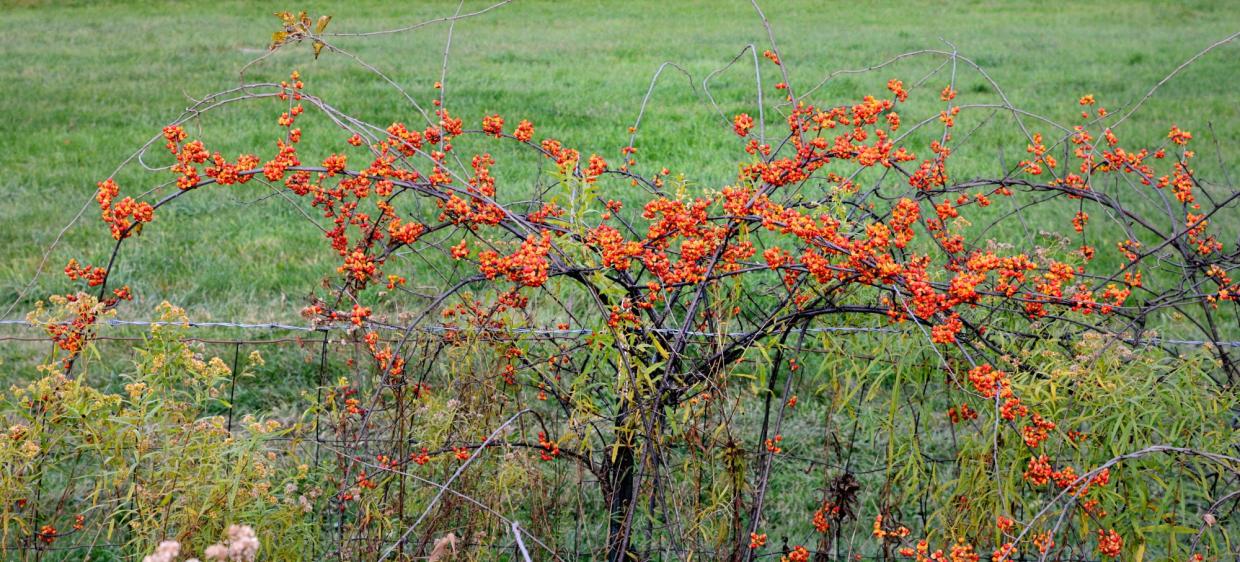
Identification: A climbing deciduous, woody vine that can grow up to 60 feet long and up to 6 inches in diameter. It can also grow along the ground spreading orange-colored roots. Young stems are brown with warty lenticels (raised pores); bark of older plants appears gray. New twig growth is smooth and green. Leaves are rounded and are narrower at the base. Small greenish flowers bloom from May to June. Yellow-orange capsules are produced from July to October. Later in the fall, the seed covering splits open to reveal red-orange seeds.
Threat: Oriental bittersweet grows fast and wraps around nearby shrubs or trees. Native woody plants can be shaded out, strangled, or uprooted. It can reproduce by seed or through root suckers.
Multiflora Rose

Identification: A deciduous shrub with arching and scrambling stems that may grow up to 10–15 feet tall. The stems are red to green with scattered, broad-based prickles. Each leaf has 5–11 elliptical leaflets with sharply serrated edges. After the flowers fade in late summer, rose hips (resembling leathery red berries) are left on the plant and remain throughout the winter.
Threat: Multiflora rose grows in dense thickets and quickly outcompetes other plants. It can completely dominate abandoned fields or pastures. Each plant can produce half a million seeds and these may remain viable in the soil for up to 20 years.
Art contest connects youth artists to nature
Attention teachers, homeschoolers, and parents: Help the children or students in your life unleash their creativity and make connections with the natural world by participating in the Massachusetts Junior Duck Stamp (JDS) art contest. Open to students from kindergarten through grade 12, this exciting and educational competition invites young artists to submit original artwork showcasing the beauty of ducks and geese and their wetland habitats. The deadline for entries is February 15, 2025.
Creating art for the JDS contest isn’t just fun, it’s an opportunity to explore nature and learn about the vital role wetlands play in supporting diverse wildlife. The JDS program combines science and art in a meaningful way, encouraging students to study waterfowl conservation and express their knowledge through artwork. The JDS curriculum is a useful resource for science and art teachers and can help engage students regardless of whether they participate in the contest.
JDS entries are judged in four age categories at the state level, with the Best of Show advancing to represent Massachusetts in the national competition. Art teachers, science teachers, and parents who home-school can visit the JDS website for entry guidelines and curriculum resources.
Get inspired, grab your art supplies, and let your passion for wildlife shine! For more information, contact Pam Landry at pam.landry@mass.gov.
Give a gift on the wild side
Now is the time of year to think about the outdoor or wildlife enthusiast on your holiday list—consider the following wildlife-related gifts available from MassWildlife.
MassWildlife Publications
- A 2-year subscription to Massachusetts Wildlife magazine ($10) delivers eight full-color issues of the Commonwealth’s best wildlife publication. The magazine is packed with award-winning articles and photos on the environment, conservation, fishing, hunting, natural history, and just about everything related to the outdoors in Massachusetts. Subscribe by mail or online.
- MassWildlife offers Massachusetts-specific field guides including Guides to Amphibians and Reptiles and Animals of Vernal Pools. Order MassWildlife publications.
Charitable Donations
For the person who has everything, make a donation in his or her name to support one of the following:
- MassWildlife's Hunters Share the Harvest Program provides an opportunity for hunters to donate and share wild game meat like venison with Massachusetts residents in need. Anyone can help financially support the program to cover the cost of meat processing and packaging. A donation of $25 will provide about 50 servings of meat for families in need!
- The Wildlands Fund is dedicated to acquiring and conserving important wildlife habitat open to wildlife-related recreation.
To donate: Send the honoree’s name with a check payable to Comm. of Mass–Wildlands Fund
Mail to: MassWildlife, 100 Cambridge Street, 6th floor Boston, MA 02114 - The Natural Heritage and Endangered Species Fund supports protection of the 400+ animals and plants listed under the Massachusetts Endangered Species Act.
To donate: Send the honoree’s name with a check payable to Comm. of MA–NHESP
Mail to: MassWildlife, NHESP, 1 Rabbit Hill Road, Westborough, MA 01581
Contact
Online
| Date published: | December 5, 2024 |
|---|

